
It all started some six years ago when dad bought himself a monster truck. The EarthCruiser is an extreme overland vehicle that requires a medium-sized step ladder to enter and a light truck license to drive. It seemed prudent of course, that I upgrade my license to selflessly provide some “cover” in case Dad needed someone else to drive it from time to time. 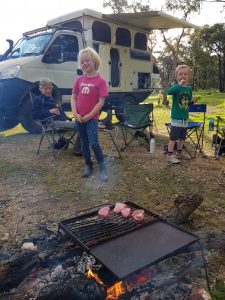
On returning from my truck license driving test in said moon buggy, I boldly announced to Anna “We’re selling the house, buying one of those and driving around the world”. Thankfully, we’ve not had to sell the house- rather entrusted that to Johnny & Tyla (watched closely by our most attentive neighbourhood might I add). We decided against buying a moon buggy, preferring to build a fair monster truck of our own, and it’s the great land of Terra Australis- not distant lands- in which we’ll create our memories.
Roll the clock forward and on the morning of Christmas Eve 2021 we hooked up our new van, for only the second time (first was the 17 min run from the dealer to the farm), and head off. The first destination was Woodend and Melbourne for some Christmas cheer and family gatherings. A wonderful week was spent between the two and before we knew it, the road train was recoupled and we were bound for the Spirit of Tasmania- the first leg of our big adventure.
It should be simple enough. However, in these ever-changing COVID times, the rules of entry seemed as uncertain as the Wallabies’ chances in next year’s Bledisloe Cup. True to form, on the eve of our departure and whilst waiting anxiously for the all-important SMS results from our Kyneton based PCR tests, news broke of the Tasmania Government loosening their entry requirements. A negative RAT result, it seemed, would be all that we’d require to be allowed in. Although, as we’d be halfway across the Bass Strait as the rules were set to deploy, some confusion remained as to which set of rules would apply.
Regardless of all this, it was onto the mighty Spirit of Tasmania we drove; the truck, the van, a boat and four excited participants. Just four I hear you ask, but where’s our namesake, Wanda, and who is this Wanda anyway?
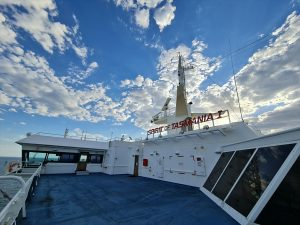
Let’s pause for a minute to clear this up. Christmas of 2020 was, like this year, clouded in COVID uncertainty. With the authorities seemingly less clear on which way to turn than Scooby-Doo in a haunted house, we made the logical decision that a world trip would simply be impractical anytime soon. Australia it was, and happily so, and at least now some firm plans could be set. One problem we had to solve however was that of Buddy and Rose, our 15- & 16-year-old beloved canines. Love them as we did, travelling Australia with a deaf & arthritic Fox Terrier Cattle X dog (not to mention dementia) and a stubborn old Kelpie X Cattle dog seemed challenging at best, sheer craziness perhaps. Graciously though, and no doubt with respect to the wonderful life they’d enjoyed, old age played its part and they both peacefully took leave to doggy heaven as 2021 rolled by. Sad as we were, it was certainly a significant logistical problem solved, solved at last until some extended lockdowns in August. The proposition was that it would be nice for the kids to have some company at home during those long and repetitive days of home-schooling. Enter Wanda, a 16-month-old, teenage mother who needed a foster home to help her find her feet. A Greyhound X Border Collie with a bit of who knows what else thrown in for good measure, she arrived to us without the pups but with all the marks of a mother who had been hard at work feeding a hungry litter. We’d foster for a month or two, see her onto a good home and pack our bags for the adventure of a lifetime….. So here we are with a tinny called The Buddy-Rose and a dog called Wanda. She’ll miss the Tassie leg, instead enjoy some life tuition from Cousin Lucy on the farm, but will commence her adventures in February when we drop back past Albury. 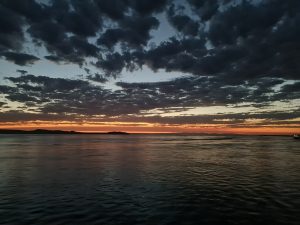 Back to the story then. As we finished the journey across Port Phillip Bay and entered the open waters of Bass Strait, we were treated to a spectacular sunset nearly 35m above the water on the forward port deck of this 194m long, 28,000-tonne vessel. An entirely timid Bass Straight it turned out to be and before we knew it, we were docked in Devonport and being woken by the ship’s captain calling those parked on Level 5 to head down to their vehicles. It was time to drive our 16m long, 9.5 tonne home on wheels out of the belly of this big ship and onto the Apple Isle.
Back to the story then. As we finished the journey across Port Phillip Bay and entered the open waters of Bass Strait, we were treated to a spectacular sunset nearly 35m above the water on the forward port deck of this 194m long, 28,000-tonne vessel. An entirely timid Bass Straight it turned out to be and before we knew it, we were docked in Devonport and being woken by the ship’s captain calling those parked on Level 5 to head down to their vehicles. It was time to drive our 16m long, 9.5 tonne home on wheels out of the belly of this big ship and onto the Apple Isle.
But what about the border controls we wondered as we drove in the daisy chain of cars, trucks, and RV’s onto the dock of Devonport and towards the check-in gates. After all the uncertainty, news headlines, and murmurings on the ship the night before, we were greeted by a cheerful quarantine officer who welcomed us to Tassie, passed over four Rapid Antigen Test kits and asked that we isolate until we’d completed the tests with a negative result. “Just let us know if you get a positive otherwise have a great trip!” she said. Simple enough, we pulled the big rig over just around the corner and proceeded to investigate further into each other’s nostrils and throats than one should ever have to in public and begin the anxious 15min wait. Single lines all-around, we were free!
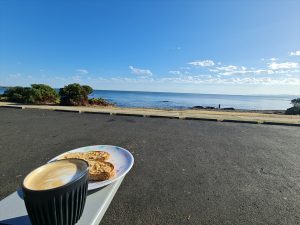
The inaugural stop was the Devonport foreshore where we enjoyed our first, of what will no doubt be many, FLEXR coffees on the road, some toast and a quick explore around the rocks as we watched a spirited group of Park Runners pass us by. Blue skies and a light breeze welcomed us to Tassie as we set a course for Smithton in the states Northwest. Along the way, we were treated to some amazing coastal driving, passing through the well-known Burnie, a major centre and busy shipping port as well as some lesser-known coastal communities like Penguin, Somerset and Wynyard. We explored the lighthouse at Table Cape before arriving at the busy settlement of Smithon to find our way to the very first camp for the trip at the sleepy but lovely River Breeze Caravan Park. New to this caravanning thing, we fumbled through our first full set-up and settled in for a few days of R&R and getting some final jobs finished on the caravan and car. Smithton proved a most useful host for this, as a key service centre for what appeared productive farming and fishing, it was well-serviced with hardware, fastener and hydraulic shops all at the ready to see our list of jobs ticked off. It was not all work however and without wasting time, the boat trailer was removed from the back of the van, assembled and the mighty Buddy-Rose effortlessly lowered from the roof of the ute. With 3m tides and 30-knot winds, it’s fair to say that Will and I had our work cut out as we navigated the narrow channels of the Duck River at the head of Morgans Bay. Whilst the fish eluded us this time, we were confident this would be the first and last time we would fail to “bring home a bag full” from our future boating adventures.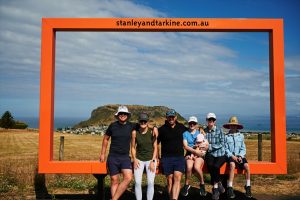 Whilst in Smithton, we were lucky enough to enjoy a visit from Anna’s brother and sister-in-law Nick & Bre and their lovely little Estelle. We travelled over from Smithton to the coastal tourist hub of Stanley where we met and enjoyed lunch at one of the many quaint outlets that Stanley has to offer. We then set off on a walk around the region’s drawcard, The Nut. The remnant of an ancient volcanic plug, The Nut stands some 150m above sea level and can be seen from all around the district. In the shadows of the chairlift, we climbed our way up the steep walking track to the top of this most unique natural landmark. As abrupt and impressive as it may be, it’s not particularly big and within the hour we’d completed the loop around the top and were soaking up the views as we rode the chairlift back down to the waiting ice-cream shop.
Whilst in Smithton, we were lucky enough to enjoy a visit from Anna’s brother and sister-in-law Nick & Bre and their lovely little Estelle. We travelled over from Smithton to the coastal tourist hub of Stanley where we met and enjoyed lunch at one of the many quaint outlets that Stanley has to offer. We then set off on a walk around the region’s drawcard, The Nut. The remnant of an ancient volcanic plug, The Nut stands some 150m above sea level and can be seen from all around the district. In the shadows of the chairlift, we climbed our way up the steep walking track to the top of this most unique natural landmark. As abrupt and impressive as it may be, it’s not particularly big and within the hour we’d completed the loop around the top and were soaking up the views as we rode the chairlift back down to the waiting ice-cream shop.
A short drive around the peninsular for some views back over Stanley and The Nut followed before leading Nick and Bre away from the beautiful, touristy, quaint Stanley and back to the much more productive hub of Smithton and the salubrious digs of the River Breeze cabin No. 4.
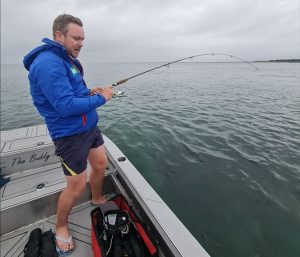
We enjoyed some King George Whiting, oysters, scallops and local wine under the now well-set awning of our 22-foot JB Caravan, Dirt Road Extreme.
The following morning, Nick and Bre were to make tracks for the West Coast and the rest of their two-week lap of Tassie and for us, it was time for the first big pack-up and a quick 25min transfer to what we discovered was a local’s mecca: Montagu Camp. Located about as Northwest as you can get and looking over to Robins Island, Montagu Camp is a large grassy, tree-covered camping area with simple amenities and a big boat ramp. To simplify the transfer, Nick & I did a quick run out with The Buddy-Rose on its trailer and thought it best we “drop her in” for a quick run whilst there. It was here that Nick landed the very first catch on this mighty vessel, a gurnard- a wild-looking thing widely hated, as we later learned, by all who fish the region. Nevertheless, the gurnard was the first fish on board all the same, that we can’t deny. With the boat out and chained up to a tree it was back into Smithton to say our goodbyes and hook up the van.
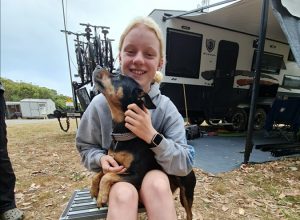
We’d met, albeit briefly, the camp’s caretaker Dan earlier in the week back in at the River Breeze. A cheerful guy with a cute dog named Toui, Dan hales from up Queensland way but now calls Smithton and Montagu home.
Montagu Camp, as it turns out is a place where many of the locals form a pop-up village of sorts for the 3-4 months over summer. For many, normal life persists as they commute, often daily, and typically dependent on the weather, back and forth from their regular lives. Camping comes in many forms, for the Montagu tragics though. It looks like tennis court-sized areas formed with 6-foot mesh fencing, some even sporting swinging timber gates. Sheds, caravans, picnic tables of all shapes are the constant though, as is the potbelly stove with a tall chimney. At first glance, this seems an odd addition, after all sitting around “the bush telly” is as much a part of camping as Slim Dusty is part of the Tamworth music festival. But as we settled in, it was Huey, the god of the weather, who brought clarity on the matter.
Wind you see, is par for the course in these parts. Perhaps if we’d approached from the West, the monster wind farms of Woolnorth and Bluff Point would have given us a hint. An open fire would not only present a safety hazard for the camp villages and trees around them but prove more exhausting than a climb up Mount Wellington as you spent your nights chasing white rabbits around the fire, escaping the inevitable swirling smoke trail.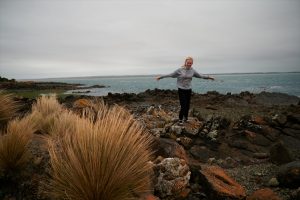
With some local knowledge from Dan, we struck camp on a nice grassy spot with the van strategically positioned to provide as much wind protection as possible whilst attracting plenty of solar onto our roof-mounted panels. Montagu would be home for the next six days as we enjoy some R&R and exploring around the region. On the windiest of days, we took leave of the camp and explored the rugged West coast region of Marrawah, Arthur River and West Point Cape where the surf must have been on as the place was littered with vans and surfers taking advantage of this remote part of Tassie coastline. We found a unique patch of rainforest hiding a fantastic short walk to the Trowutta Arch, a fascinating rock feature and water hole. Built-in 2019, the Smithton Indoor Leisure Centre is a well-equipped modern facility and provided us with some exercise and importantly, hot showers. But when the wind abated, we explored the rocks and waters around the before-mentioned boat ramp. The area is a bit of a fishing haven with Flathead, Leatherjacket, Aussie Salmon to chase, not to mention the relatively close-by open waters and all they have to offer. But it’s the monster King George Whiting which is prized in the more protected waters of the area.
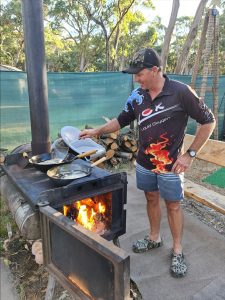
On about night 2 or 3, enjoying a walk by the water we met one of the many friendly locals, Clayton. A cattle and cropping farmer from near Stanley, Clayton and his family have been coming to Montagu for over 20 years. For at least three months, sometimes longer, they live between the farm and their well-appointed camp amongst the trees. An understated kind of guy, as the week rolled by we began to realise he is most certainly one of the regions gun fishos. Accordingly, it was without hesitation that the kids & I took up an invitation to join him on his tinny, for a late afternoon fish in the waters just of Montagu. Probably just good luck I guess, but it seemed this effort was far more productive than our previous as we hit two or three spots Clayton knew and filled our bag with the prized whiting, a tough fighting and great eating white-fleshed fish. Plenty of Leather Jackets were also landed, all but a couple returned, and whilst a final tally was not taken, all crew got to experience the bending of the rod. No doubt it will be a couple of hours the kids and I will remember for some time to come. But it’s not just guiding, Clayton proceeded to clean and fillet the fish, as we chatted on the foreshore and got monstered by sandflies, and in no time we had enough whiting fillets to feed a small army. The following night, we gratefully accepted an invitation into Clayton and Amanda’s camp to feast on some of the spoils and thoroughly enjoy an evening by their highly refined and engineered potbelly stove. Crumbed and fried whiting, deep-fried flake, salads and good company were in abundance. Clayton and Amanda were just some of the wonderfully friendly people we got to meet in our stay in Smithton and Montagu, a theme that would persist as we continue on our journey around this amazing little state.
At some point however we must move on, and having endured some extraordinary winds in the week we were there, we were now confident we could “strike camp” with the best of them.
As such, we packed up and made tracks for the rest of the west coast. To be continued….